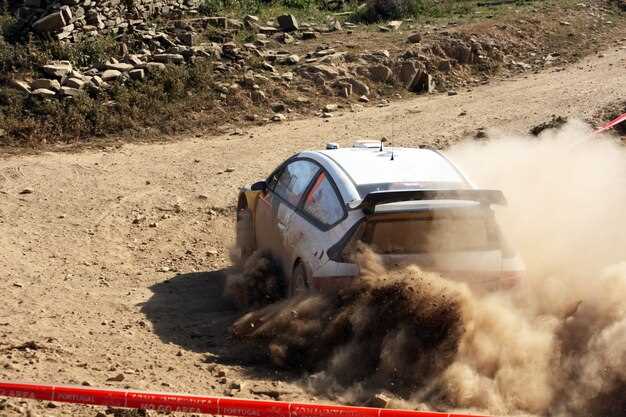
Building a race-legal off-road vehicle requires a thorough understanding of both the construction process and the specific rules governing off-road competitions. Whether you are a seasoned mechanic or a passionate newcomer, familiarizing yourself with the regulations is crucial for ensuring your vehicle meets the necessary criteria for racing.
The journey to creating an effective off-road vehicle starts with selecting the right platform. Vehicles must not only be robust and durable but also comply with the rules that dictate what modifications are permissible. These regulations often vary by racing series and location, which means carefully reviewing the rulebook is an essential first step in your project.
As you embark on this exciting endeavor, consider the fundamental aspects of design and performance. The goal is to build a vehicle that can navigate challenging terrains while adhering to safety standards and competition rules. From suspension choices to tire selection, every decision will impact your vehicle’s performance in the unforgiving world of off-road racing.
Selecting the Right Base Vehicle for Off-Road Modifications
Choosing the appropriate base vehicle is crucial for building a race-legal off-road vehicle that meets specific regulations and performance requirements. The first factor to consider is the manufacturer’s reputation for off-road capabilities. Vehicles designed for rugged terrain typically have a sturdier frame, enhanced suspension systems, and higher ground clearance, making them ideal candidates for modifications.
Next, examine the vehicle’s weight and size. Lightweight vehicles often provide better maneuverability and agility in off-road conditions, while larger ones can offer additional stability and power. Balancing these aspects according to your racing rules and personal preferences will play a significant role in your build strategy.
Another essential consideration is the availability of aftermarket parts and support for the chosen vehicle. Popular off-road models often have a wide array of modification options, allowing you to customize performance and aesthetics. Check local regulations to ensure that your modifications will remain within race-legal limits.
Lastly, consider the drivetrain configuration. Four-wheel drive (4WD) systems are typically preferred for off-road builds, as they provide improved traction and control on uneven surfaces. Pay attention to the engine type and power output as well, as these factors will influence your vehicle’s performance in competitive environments.
Understanding Local Off-Road Vehicle Regulations and Compliance
When embarking on the journey to build a race-legal off-road vehicle, it is crucial to familiarize oneself with the rules and regulations governing off-road vehicles in your area. These regulations can vary significantly between different regions, and compliance is essential to ensure that your vehicle is not only legal but also safe for competition and recreational use.
Firstly, identify the specific requirements imposed by local authorities, which may include vehicle specifications, safety features, and environmental standards. Many jurisdictions mandate that off-road vehicles must adhere to certain noise and emissions levels, which could influence your build decisions. Understanding these compliance factors can help in selecting the right components and design elements for your vehicle.
In addition to vehicle specifications, there are often licensing and registration requirements for off-road vehicles. Some areas may require you to register your build as a street-legal vehicle, while others may have specific licenses for off-road use. It is essential to check with your local Department of Motor Vehicles (DMV) or equivalent agency to ensure all necessary paperwork is completed before hitting the trails or tracks.
Moreover, participation in off-road racing events typically involves adherence to strict safety regulations. These may cover everything from roll cage requirements and harness specifications to fire suppression systems. Understanding these rules is vital to keep both drivers and spectators safe during competitions.
Lastly, engaging with local off-road communities or clubs can provide valuable insights into navigating the regulatory landscape. Fellow enthusiasts often share their experiences regarding compliance and can offer guidance on how to build a vehicle that meets local standards while still delivering performance on the track.
Key Modifications to Enhance Performance and Safety
When building a race-legal off-road vehicle, it is essential to focus on modifications that not only enhance performance but also ensure compliance with racing legality and safety rules.
Here are some crucial modifications to consider:
-
Suspension Upgrade
Improving your vehicle’s suspension system increases stability and handling over rough terrain. Consider adjustable shock absorbers and heavy-duty springs for optimal performance.
-
High-Performance Tires
Select tires that offer better traction on various surfaces. All-terrain or mud-terrain tires can significantly improve grip and handling.
-
Lightweight Frame
Reducing the vehicle’s weight enhances acceleration and overall speed. Consider using lightweight materials such as aluminum or carbon fiber for body panels.
-
Brake System Upgrade
Safety is paramount, so upgrading to high-performance brakes ensures better stopping power. Look for ventilated rotors and performance brake pads.
-
Engine Performance Enhancements
Modifying the engine with performance chips, cold air intakes, or turbochargers can significantly increase horsepower and torque.
-
Safety Equipment
Installing proper safety gear is crucial for both legality and protection. This includes:
- Roll cages
- Five-point harnesses
- Fire extinguishers
- Racing seats
-
Lighting System
Upgrading to high-intensity discharge or LED lights enhances visibility during night races while following the prescribed racing regulations.
By implementing these modifications, you not only boost the performance of your off-road vehicle but also ensure it meets the necessary legality and safety standards for racing. Always consult the specific rules of the racing organization to remain compliant during your build process.
Essential Equipment for Off-Road Construction and Upgrades

Building a race-legal off-road vehicle requires careful consideration of essential equipment that not only enhances performance but also adheres to the relevant rules and regulations. Understanding the legality of each component is crucial to ensure successful upgrades and modifications.
One of the primary elements is a high-performance suspension system. This component helps to absorb shocks and improves handling on rugged terrains. Investing in adjustable coilovers or long-travel suspension kits can significantly enhance the vehicle’s capabilities. Always check with your local regulations to ensure your suspension modifications comply with legality standards for off-road racing.
Next, a robust roll cage is vital for safety and structural integrity. A well-designed roll cage protects the driver and passengers in the event of a rollover. Be sure to adhere to specific measurements and materials outlined in the racing guidelines to maintain legality and effectiveness.
Another critical aspect is the drivetrain upgrade, which often includes a high-torque transmission and diff lockers. These components improve traction and power delivery, essential for navigating challenging terrains. It’s important to research and select upgrades that meet both performance expectations and rules set forth by racing authorities.
For optimal performance, a quality set of all-terrain tires is non-negotiable. Tires designed for off-road conditions offer superior grip and durability. However, ensure that the tire size and type comply with your local racing league’s legality regulations to avoid penalties.
Furthermore, a powerful engine with appropriate performance enhancements, such as aftermarket tuners and cold air intakes, can provide the necessary power boost. Ensure any engine modifications align with emissions standards and rules governing off-road vehicles.
Lastly, safety equipment, including harnesses, helmets, and fire extinguishers, is not only crucial for protection but often mandated by racing organizations. Confirm these safety measures align with legality requirements to ensure a compliant and safe racing experience.
In conclusion, assembling the right equipment for off-road construction and upgrades is paramount for both performance and compliance with rules and legality in racing environments. Take the time to research and select each component responsibly to create a vehicle that thrives on rugged trails while adhering to necessary standards.
Testing Your Vehicle for Race Readiness and Legal Compliance

To ensure your off-road vehicle is ready for competition, rigorous testing is essential. Begin by examining the legality of your vehicle, adhering to the specific rules set by the race organizers. Each racing event may have unique requirements concerning engine size, safety features, and optional modifications.
Conduct a thorough inspection to verify that all components meet the technical specifications mandated by the racing body. This includes checking the frame, suspension, tires, and drivetrain. Make sure all elements are properly secured and in good working condition to enhance performance during races.
Next, perform a comprehensive systems check. This involves testing the braking system, steering, and safety features such as roll cages and harnesses. Proper function of these systems is crucial for both safety and compliance; they must align with legal standards to avoid disqualification from events.
Documentation is another key aspect of verifying legality. Keep all necessary paperwork, such as registration and proof of compliance with environmental regulations, easily accessible. This documentation not only supports your vehicle’s legality but also assures officials of your commitment to following racing rules.
Finally, conduct trial runs in a controlled environment. These test drives can help you identify any issues that need addressing before the actual event. Pay attention to how the vehicle handles off-road conditions, making adjustments as needed to enhance both performance and safety. This process will ensure your vehicle stands up to the demands of racing while remaining in compliance with legal standards.
Maintaining Off-Road Vehicles for Long-Term Performance and Reliability
Maintaining off-road vehicles is crucial for ensuring their long-term performance and reliability, especially for those who build their vehicles for racing or adventurous exploration. Proper maintenance practices can significantly extend the vehicle’s lifespan and optimize its capabilities in challenging terrains.
Firstly, regular inspections should be part of your maintenance routine. Check the vehicle’s critical components, such as the suspension system, brakes, and drivetrain, for any signs of wear and tear. Adhering to manufacturer guidelines and industry rules regarding maintenance intervals can help identify potential issues before they become significant problems.
Fluid levels are another important aspect of maintenance. Regularly check and change engine oil, transmission fluid, and differential fluid as recommended. Clean and replace filters to ensure that your off-road vehicle runs smoothly. Contaminated fluids can lead to poor performance and costly repairs.
Tires are the lifeline of any off-road vehicle. Inspect the tires for uneven wear, proper air pressure, and any signs of damage. Rotate tires periodically and replace them when they reach their tread limit. Selecting appropriate tires based on the specific off-road conditions you plan to face can enhance traction and vehicle stability.
Another essential maintenance task is to keep the vehicle clean. Mud and dirt accumulation can lead to corrosion and hinder performance. Thoroughly wash the undercarriage and any specific areas prone to mud buildup after off-road excursions. Using rust protectants can also shield metal components from moisture and salt, prolonging their life.
Routine inspections of electrical systems, including wiring and battery conditions, are critical to ensure reliable performance. Be alert for any signs of corrosion on battery terminals and ensure connections are secure. Regularly test lights and other electrical components to avoid failures during critical moments.
Finally, investing in performance upgrades can also aid in reliability. Quality parts designed specifically for off-road use can offer enhanced durability and performance. Consult guidelines that address modifying off-road vehicles to ensure compliance with racing rules, as modifications may affect legality during competitive events.




